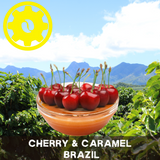Tangy Morello cherry & smooth sweet caramel with a maple syrup finish
This is a very enjoyable Brazilian coffee produced by a family-run coffee farm by the name of Mió in Monte Santo de Minas, a municipality in the south of the state of Minas Gerais, Southeastern Brazil.
This is a single varietal coffee, yellow Catucaí, the altitude is 1100m, and the process is Red Honey, which is a processing method that involves up to 80% of the flesh of the cherry remaining when the beans are left to dry, which leads to a fuller-bodied coffee. The Speciality Coffee Association score is 84.5, and the roast profile is medium.
This is a flawless Brazilian coffee, bursting with flavour, which makes it quite difficult to describe, but for me the most prominent flavours are bright and tangy Morello cherries & smooth, sweet caramel.

How it Tastes
This is a flawless Brazilian coffee with a big body & bursting with flavour, thanks partly to the red honey natural process.
By the way, there's no honey used in the red honey process, a common misconception. This is simply the name used to describe this processing method, in which up to 80% of the cherry is left on the beans when drying.
The body is thick and smooth, and although there's quite a lot going on with the taste, meaning I could describe lots of flavour notes, the most prominent flavours for me are bright and tangy Morello cherries & smooth, sweet caramel.
Fazenda Mio
Mió is a family-owned (the Pellicer family) coffee farm in Monte Santo de Minas in Brazil, who refused to give in to defeat, and started from scratch after the catastrophic frosts of 1975 which destroyed roughly half of Brazil's coffee trees!
It took them over 10 years, but they finally managed to start again, beginning with a tiny plot of land and just 6 coffee trees! Now, Fazenda Mió is one of the major producers in the area, and the farm spans almost 1600 hectares between Southern Minas Gerais and the Mogiana highlands. This is a producer dedicated to preserving the local biodiversity, in fact much of their land is left as untouched, natural native forest.







